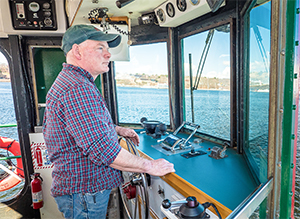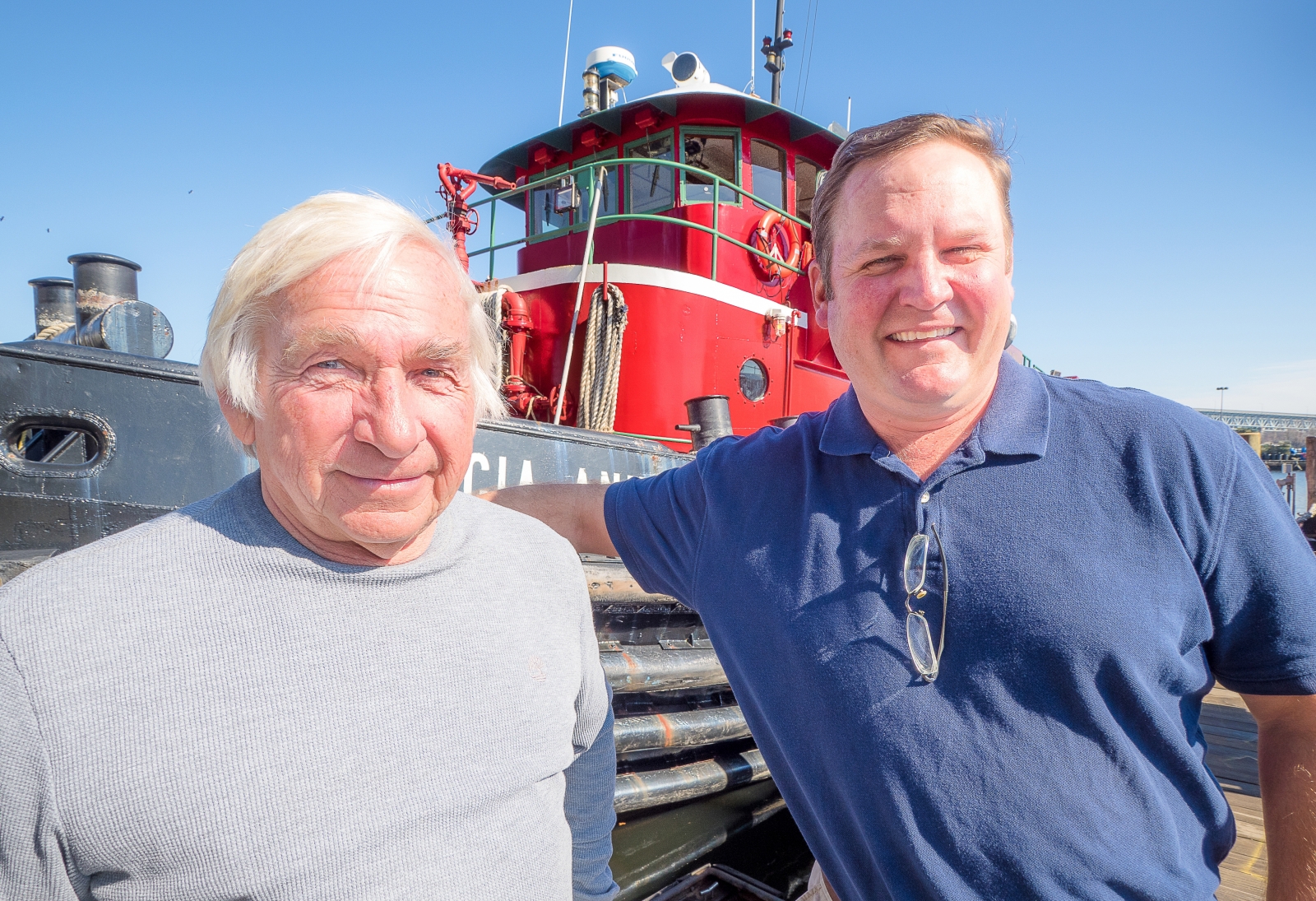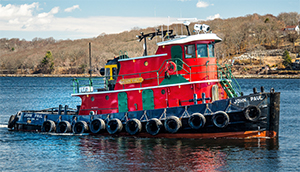In New London, Conn., the Wronowski family knows the waterfront and is present on much of it. In 1967 John Henry Wronowski bought the Thames Towboat Co. from the Chappell family, who had founded the company in 1865, naming it after the river running between New London and Groton and emptying into Long Island Sound. The acquisition included a shipyard, a key component in the Wronowski business plan.
“My grandfather, John H., the H for Henry, had a keen sense for buying good used equipment,” said Adam Wronowski, vice president of Thames Towboat Co. Adam’s father, John P. Wronowski, the P for Peter, is president of the company.
Evidence of that sense is in abundance at the Wronowskis’ string of operations spread along the Thames River, beginning with the family’s Cross Sound Ferry Services and Block Island Ferry terminals and the four bright red tugs moored out in front of the company’s red brick office. Farther upriver is the sprawling Thames Shipyard and Repair Co. with a fistful of ferries, both Wronowski-owned as well as others, in slips or dry dock for repairs and maintenance.
Upriver, in distant view, are two splotches of red indicating the company’s two z-drive tugs, contracted full time to the Navy’s Naval Submarine Base New London.
 |
|
Capt. John Skerry at the helm. |
One of the tugs at the submarine base is the 90-foot, 3,600-hp azimuthing stern drive (ASD) tug Paul A. Wronowski built at the Thames Shipyard in 1980. “It is one of the first ASDs on the East Coast,” said Adam. “And it was the first z-drive tug to assist tugs for the Navy.”
The design for Paul A. combined the innate engineering instincts of John H. Wronowski and the expertise of naval architect Bob Hill, who at the time was working at John Gilbert Associates of Hingham, Mass. Hill is now owner of Ocean Tug & Barge. The tug is named for Adam’s late uncle.
Paul A. Wronowski is powered by two Cummins KTA-3067-M mains with Niigata reduction gears at a 2.51:1 ratio and Niigata ZP-2 z-drives. Unlike most modern ASD tugs, the towing winch is on the stern. And that keen eye for good used machinery led John H. to choose an Almon Johnson towing winch.
Adam Wronowski explained that the Almon Johnson winch was designed by the Navy as an anchor winch for its LST fleet. Each of the tank landing ships carried two of the winches on the stern. “They built hundreds of them,” said Adam. “This one is 70 years old, but we rebuilt it and it’s a great winch.” Cape Henlopen, one of the 10 ferries in the Wronowskis’ ferry fleets, was LST 510 when it landed at Normandy on D-Day.
 |
|
John Paul’s pilothouse includes a Henschel Siemens hydraulic steering system and a Sperry Piedmont rudder order. Skerry says “it’s Navy-speced and it’s lightning fast.” |
The other tug at the submarine base is the 96-foot, 3,400-hp ASD tug John P. Wronowski, named for Adam’s father. John P. was designed by Jensen Maritime Consultants of Seattle and built at Eastern Shipbuilding in Panama City, Fla., in 2004. Powered by two Cummins KTA50-M2 16-cylinder mains with Schottel 1010 azimuthing stern drives, John P. Wronowski has JonRie towing winches on the bow and the stern.
Downriver, the Thames Towboat’s harbor fleet is evidence of the Wronowski eye for diamonds in the rough. The main workhorse of the harbor fleet is Patricia Ann, named for Adam’s late aunt and built for the Navy in 1960 as the YTB 758 Paducah by Southern Shipbuilding of Slidell, La. The tug was stationed in Norfolk, Va., until disposed of at a naval surplus auction in 2001.
That is where and when the aging vessel came under the Wronowski eye. “She was the oldest of the four tugs on the block,” said Adam. “The Navy crews had scavenged the other three to keep other old tugs going, stripping them of things like the steering controls.” Although the oldest up for auction, YTB 758 had continued to operate while the others were being cannibalized, their parts likely being transplanted to keep the aging Paducah going. “It was the only one of the four in operating condition,” said Adam. “It went for the least price of the four, but we were the high bidder. We just dusted her off and cleaned things up and she ran fine.”
 |
|
The house of John Paul, with Skerry on watch as the boat travels up the Thames River near the Gold Star Memorial Bridge between New London and Groton. |
Although in working order, Patricia Ann took the run upriver to the shipyard for a repower, the original Fairbanks Morse engine giving way to a 12-645 EMD turbo main coupled to the original 5.1:1 Lufkin reduction gear. The propulsion train turns a skewed four-blade 144-by-120-inch open propeller producing 2,500 hp. “This is the best-matched engine gear and prop I have ever encountered,” said Adam. “Although we haven’t measured bollard pull, the docking pilots have suggested it pushes like a 3,000-hp-rated twin-screw tug.”
At the same time, Patricia Ann was fitted with a 325-hp Harbormaster bow thruster and a 350-hp Harbormaster stern thruster. “The tug has worked out perfectly for us,” said Adam. Typically the tug docks ships with a headline. The stern thruster allows the helmsman to hold the tug steady and perpendicular to the ship while maneuvering.
“Right now we use a soft line and H-bitt, but we have another Almon Johnson winch ready that we will fit the tug out with this summer,” said Adam. “The winch will make it a lot easier on the crew.”
On a tour of Patricia Ann, Capt. John Skerry — also the engineer and answering tug manager for the company — expanded on the thruster advantage. Thames Towboat has a contract with General Dynamics’ Electric Boat facility in Groton, visible across the river from the Thames Towboat dock. The agreement calls for Patricia Ann to tow a special jack-up barge that secures submarine modules during transit from Electric Boat’s manufacturing facility at Quonset Point, R.I., to the Groton assembly plant. The tug crew must shift from a towing makeup to an on-the-hip makeup during docking.
 |
|
John Paul Wronowski and son Adam Wronowski own Thames Towboat, Cross Sound Ferry, Block Island Ferry and Thames Shipyard. |
“We round up about a mile out and make up on the hip to bring the tow in,” said Skerry. “The bow thruster makes it much easier to move from towing to the hip. And the bow thruster makes it a really fun tug to run. We can do stuff a twin-screw can’t do, like go sideways.”
Patricia Ann’s engine room could be a Detroit Diesel museum. There are six DD engines if you include the GM EMD turbo main engine, surrounded by a DD 12-71 driving the stern thruster, a DD 8-71 driving the bow thruster, a DD 6-71 driving the fire pump and two DD 6-71 60-kW generators.
The tug John Paul is named for Adam’s oldest son. A proud moment for Adam was being at the helm of John Paul, towing Mystic Seaport’s historic whaling vessel Charles W. Morgan out to Long Island Sound for sea trials. The ship had undergone a major restoration, completed by Mystic’s Henry B. duPont Preservation Shipyard in 2013. Charles W. Morgan is the world’s oldest floating merchant vessel. “I had the pleasure of running the tug twice for the ship’s trials, and it was a real treat to do it,” said Adam.
 |
|
Capt. Geoffrey Woods on this day working as a deck hand aboard John Paul. |
John Paul, the only twin-screw tug in the harbor fleet, was built by Houma Shipbuilding in Houma, La. Thames Towboat acquired the tug, then named Katrina, from Detyens Marine Industries in 2003. As with any floating equipment the company acquires, John Paul headed upriver to the shipyard. In 2008, the existing Cummins mains were replaced with refurbished Cummins KTA19-M2 600-hp engines. The gears are Twin Disc MG-516s at a 5:1 reduction ratio turning four-blade 72-by-58-inch fixed-pitch propellers in Kort nozzles. The tug was fitted with submarine fenders.
Two classic conventional tugs in the Thames Towboat fleet were built by the Ira S. Bushey & Sons shipyard on the Gowanus Canal at the foot of Court Street behind Red Hook, Brooklyn, N.Y. Thameship, built in 1940 as YT-36, and Towmaster, built in 1952 for a private company, were acquired by Thames Towboat in 1970 and 2004, respectively. “They built a lot of the same tug for the government, the Navy and for private companies,” said Adam.
They were identical, at least originally, and only one example of the plethora of identical tugs delivered by Bushey over the years. “There are a lot of them out there,” he said.
Both 94-foot tugs — with a string of names and owners behind them — were sent upriver to Thames Shipyard, their original 1,200-hp Fairbanks Morse engines giving way to 2,000-hp 16-645 EMD mains. They were fitted with submarine fendering and run soft line with an H-bitt on the stern.
 |
|
Skerry, who serves as captain, engineer and tugmaster for Thames, with an EMD turbo aboard the 2,500-hp Patricia Ann. |
The little 36-foot 350-hp tug Adam was built in 1983 at the Thames Shipyard. “That one is named for me,” said Adam with a chuckle. Powered by a 12-71 Detroit Diesel, Adam is a handy tug for docking vessels into tight slips at the shipyard and, fitted with submarine fenders, also assists submarines at Electric Boat. “It has a steerable Kort nozzle that makes the tug very maneuverable,” said Adam.
The Wronowskis know good used equipment when they see it. They also have a good sense of the benefits of diversity. Adam explained that the tug business is steady with the Electric Boat and the Navy contracts anchoring the tug fleet. But the Cross Sound Ferry Services, the Block Island Ferry and the shipyard figure largely in their business equation.
Whereas the Chappells developed the shipyard over 100 years ago to build their tug fleet, the Wronowskis — Paul A. and Adam aside — utilize the yard primarily for repair and maintenance.
“We have such a nice niche here,” said Adam. “We’re set up for repair and there are lots of ferries in the Northeast. We draw repair work from Massachusetts down as far as Cape May on the Delaware.”

